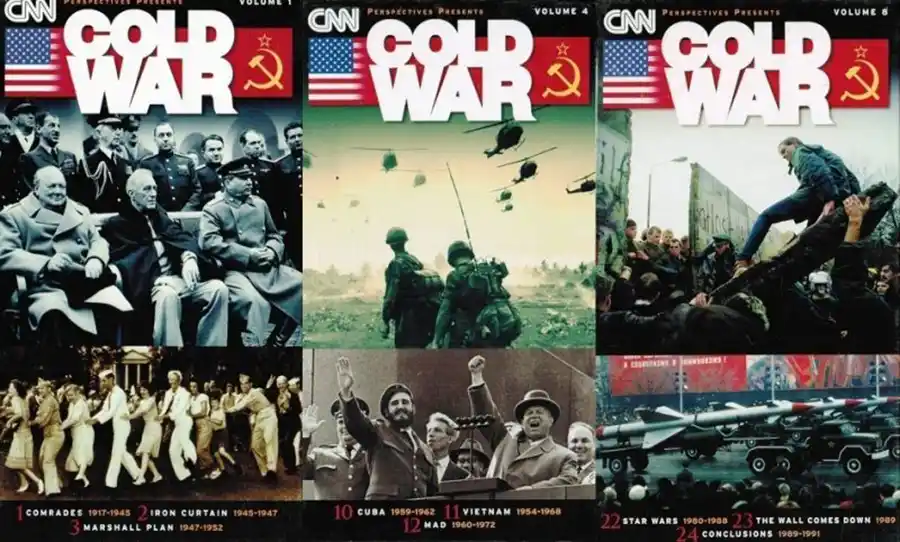Cold War episode 17 – Detente 1969-1975: In the early 1970s, North Vietnam launched a new offensive against the South, prompting the United States to intensify its bombing campaign in an effort to bring an end to the conflict. At the same time, the U.S. government, under President Richard Nixon, sought to establish peace through diplomatic means, building closer relations with both China and the USSR. As part of this strategy, Nixon and Soviet leader Leonid Brezhnev signed the Strategic Arms Limitation Treaty (SALT) in 1972, marking a significant step toward détente between the two superpowers. Meanwhile, West German Chancellor Willy Brandt pursued his Ostpolitik strategy, which aimed to normalize relations between West Germany, East Germany, the USSR, and Poland.
Despite considerable opposition at home, the U.S. bombing campaigns in Cambodia and Hanoi proved successful in bringing North Vietnam to the negotiating table. This led to the Paris Peace Accords in 1972, which, although deeply resented by South Vietnam, temporarily halted the fighting in the region. Unfortunately, the Paris Peace Accords ultimately failed to prevent the fall of Saigon in 1975, as North Vietnam continued its push for reunification. In the same year, détente efforts culminated in the Helsinki Declaration, which enshrined human rights and territorial integrity as key principles in international relations.
Additionally, the historic Apollo-Soyuz Test Project in 1975 served as a symbolic display of cooperation between the United States and the Soviet Union in the midst of the Cold War. Key figures involved in these events include U.S. Secretary of Defense Melvin Laird, Russian cosmonaut Valeri Kubasov, American diplomat Winston Lord, Nixon aide John Ehrlichman, and future U.S. President Gerald Ford. Their insights and experiences provide invaluable context and understanding of this tumultuous period in world history.
Cold War episode 17 – Detente 1969-1975 – Tensions, Détente, and the Struggle for Peace
The Vietnam War and U.S. Involvement
As the United States was deeply entrenched in the Vietnam War, the conflict became a focal point for global tensions between the U.S. and the USSR. The war was a complex web of alliances, pitting the communist regime of North Vietnam, supported by the Soviet Union, against the non-communist South Vietnam, backed by the U.S. and its Western allies.
With the election of Richard Nixon in 1968, the U.S. sought to extricate itself from the quagmire of the Vietnam War while preserving its credibility as a global superpower. Nixon’s administration increased bombing campaigns in North Vietnam and expanded the conflict into neighboring Cambodia, hoping to force Hanoi to negotiate a peace agreement. Simultaneously, the U.S. pursued diplomatic channels with the Soviet Union to reduce tensions and establish an environment conducive to peace talks.
Diplomatic Efforts and Arms Control
During this period, the U.S. pursued a strategy of détente, seeking to ease tensions with the USSR and foster a more stable and peaceful international environment. This approach aimed to reduce the risk of nuclear war and promote cooperation in areas of mutual interest.
One of the most significant diplomatic achievements during this period was the signing of the Strategic Arms Limitation Treaty (SALT) in 1972. This agreement, signed by President Nixon and Soviet leader Leonid Brezhnev, marked a critical turning point in the Cold War, as both superpowers agreed to limit their nuclear arsenals.
In addition to SALT, other diplomatic initiatives included West German Chancellor Willy Brandt’s Ostpolitik strategy and the normalization of relations between the U.S. and China. These efforts aimed to create a multipolar world order and reduce the likelihood of conflict by engaging with adversaries and fostering dialogue.
The Helsinki Declaration and the Legacy of Détente
The era of détente culminated in the Helsinki Declaration of 1975, which reaffirmed the principles of human rights, territorial integrity, and peaceful coexistence. This landmark agreement was signed by 35 countries, including the U.S. and the USSR, and helped to solidify the norms and principles that would guide international relations in the latter half of the 20th century.
While the détente period did not entirely eliminate tensions between the superpowers, it played a crucial role in reducing the risk of direct conflict and promoting diplomatic engagement. The legacy of détente can still be felt today, as the world navigates an increasingly complex and interconnected geopolitical landscape.




